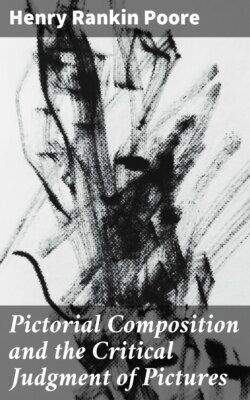Читать книгу Pictorial Composition and the Critical Judgment of Pictures - Henry Rankin Poore - Страница 15
На сайте Литреса книга снята с продажи.
TRANSITION OF LINE.
ОглавлениеTable of Contents
More effective than opposition, as the cross bar is more effective for strength than the bar supported on only one side, is Transition, or the same item carried across, or delivered to another item which shall cross a line or space.
In the group of peasants in the Cabaret note the use of lines of opposition and transition, in the single figures and when taken in twos. The laborer (with shovel) in his upper and lower extremities exhibits a large cross which becomes larger when we add the table on which his extended arm rests and the figure standing behind him. The ascent of this vertical is stopped by the line of the mantel and then continued by the plate and picture. So in minor parts of this group one may think out the rugged energy of its composition, nor anywhere discover a single curved or flowing line. Nor does it require an experienced eye to note the pyramidal structure of the various parts. In the action of the heads [pg 56] and bodies of the two central figures is another strong example of oppositional arrangement. The heavily braced table is typical of the whole.
In landscape the transitional line from land into sky is often impossible and objectionable. The sentiment of the subject may deny any attempt at this union. Here the principle only, should be hinted at. In the case of a sunset sky where the clouds float as parallel bars above the horizon and thus show the character of a quiet and windless closing of day, a transitional line such as a tree, mast or spire may be unavailable. Oppositional spots or lines attracting the vision into the land and thus diverting it from the horizontals are the only recourse. In the shore view the sun's rays create a series of lines which admirably unite with the curve of the wagon tracks. The union of sky and land is thus effected and meanwhile the subject proper has its ruggedness associated with the graceful compass of these elements.
In fact transitional line is so powerful that unless it contains a part of the subject it should seldom be used.
In the “Annunciation” by Botticelli the introduction of a long perspective line beyond the figures, continuing the lines of the foreground, railroads the vision right through the subject, carrying it out of the picture. If the attention is pinned perforce on the subject, one feels the interruption and annoyance of this unnecessary landscape. The whole Italian school of the Renaissance weakened the force of its portraits [pg 57] and figure pictures by these elaborate settings which they seemed helpless to govern. In Velasquez we frequently find the simplification of background which saves the entire interest for the subject; but even he in his “Spinners” and to a lesser degree in some other compositions, makes the same error. In the greatest of Rembrandt's portrait groups, “The Syndics,” his problem involved the placement of six figures. Four are seated at the far side of a table looking toward us, the fifth, on the near side, rises and looks toward us. His head, higher than those of the row of four, breaks this line of formality; but the depth and perspective of the picture is not secured until the figure standing in the background is added. This produces from the foreground figure, through one of the seated figures, the transitional line which pulls the composition forward and backward and makes a circular composition of what was commenced upon a line sweeping across the entire canvas.
The hillside entitled “Pathless,” by Horsley Hinton is a subject easily passed in nature as ordinary, which has been however unified and made available through the understanding of this principle. So much of an artist is its author that I can see him down on his knees cutting out the mass of blackberry stems so that the two or three required in the foreground should strike as lines across the demi-dark of the lower middle space. The line of the hill had cut this off from the foreground and these attractive lines are as [pg 58] cords tying it on. From the light rock in the lower centre the eye zigzags up to the line of hillside, cutting the picture from one side to the other. Fortunately nature had supplied a remedy here in the trees which divert this line. But this is insisted on in the parallelism of the distant mountains. The artist, however, has the last word. He has created a powerful diversion in the sky, bringing down strong lines of light and a sense of illumination over the hill and into the foreground. The subject, unpromising in its original lines, has thus been redeemed. This sort of work is in advance of the public, but should find its reward with the elect.
